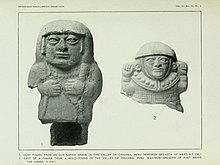Urmonotheismus
| Part of a series on |
| Anthropology of religion |
|---|
 |
| Social and cultural anthropology |
The term Urmonotheismus (
History
In 1898, the Scottish anthropologist Andrew Lang proposed that the idea of a Supreme Being, the "high God", or "All Father" existed among some of the simplest of contemporary tribes prior to their contact with Western peoples,[2] and that Urmonotheismus ("primitive monotheism") was the original religion of humankind.
The Catholic priest
A significant part of the work of Italian
Schmidt's hypothesis was controversially discussed during much of the first half of the 20th century. In the 1930s, Schmidt adduced evidence from
According to Pettazzoni's analysis, Schmidt confused science and
By the 1950s, the academic establishment had rejected the hypothesis of primitive ethical monotheism (but not per se other proposed versions of Urmonotheismus), and the proponents of Schmidt's "Vienna school" rephrased his ideas to the effect that while ancient cultures may not have known "true monotheism", they at least show evidence for "original
See also
- Anthropology of religion
- Evolutionary origin of religions
- History of religion
- Prehistoric religion
- Deism
- Ethical monotheism
- Fitra
- God gene
- Hanif
- Irreligion
- Naturalistic pantheism
- Neuroscience of religion
- Nontheistic religion
- Psychology of religion
- Religious naturalism
- Spiritual naturalism
- The One (Neoplatonism)
Notes
- ^ Smart, Ninian (10 November 2020) [26 July 1999]. "Polytheism: The nature of polytheism". Encyclopædia Britannica. Edinburgh: Encyclopædia Britannica, Inc. Archived from the original on 11 November 2020. Retrieved 25 April 2021.
Belief in many divine beings, who typically have to be worshipped or, if malevolent, warded off with appropriate rituals, has been widespread in human cultures. Though a single evolutionary process cannot be postulated, there has been a drift in various traditions toward the unification of sacred forces under a single head, which, in a number of nonliterate 'primal' societies, has become embedded in a supreme being. Sometimes this being is a deus otiosus (an 'indifferent god'), regarded as having withdrawn from immediate concern with men and thought of sometimes as too exalted for men to petition. This observation led Wilhelm Schmidt, an Austrian anthropologist, to postulate in the early 20th century an Urmonotheismus, or 'original monotheism,' which later became overlaid by polytheism. Like all other theories of religious origins, this theory is speculative and unverifiable. More promising are attempts by sociologists and social anthropologists to penetrate to the uses and significance of the gods in particular societies.
- ^ a b
Dhavamony, Mariasusai (1973). Phenomenology of religion. Editrice Pontificia Università Gregoriana. pp. 60–64. ISBN 88-7652-474-6.
The evolutionary view of the history of religions saw religion as progressing from the most simple forms like preanimism, animism, totemism to higher forms like polytheism and finally monotheism.
- ^ OCLC 50557232.
- ^ ISBN 9780567374158.
- ^ High Gods in North America, 1933
- ^ The Origin and Growth of Religion: Facts and Theories, 1931
- ^ a b
ISBN 9780815404088. Retrieved 1 April 2023.
- ^
Brandewie, Ernest (1983). Wilhelm Schmidt and the Origin of the Idea of God. Reference, Information and Interdisciplinary Subjects Series. Lanham, Maryland: University Press of America. p. 251. ISBN 9780819133632. Retrieved 1 April 2023.
- ^ Brandewie, pages 44 and 119
- ^ Sir Edward Evans-Pritchard, Theories of Primitive Religion, New York: Oxford University Press, 1987, pages 104–105
